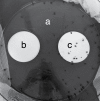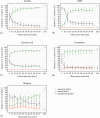Methods for Testing Repellents Against Bed Bugs (Hemiptera: Cimicidae)
- PMID: 33420500
- PMCID: PMC7871147
- DOI: 10.1093/jee/toaa304
Methods for Testing Repellents Against Bed Bugs (Hemiptera: Cimicidae)
Abstract
Bed bug repellents should not only prevent humans from being bitten but impede an infestation of personal belongings. Only a few test proposals for evaluating the efficacy of repellents against bed bugs have been published so far. In the present study, two test systems were assessed for efficacy testing with five potential bed bug repellents (cinnamon oil, icaridin, N,N-diethyl-3-methylbenzamide (DEET), permethrin, and margosa extract). The first test setup was a harborage choice test system that consisted of a crystallizing dish with a treated and an untreated harborage. Sixty minutes and 24 h after treatment, DEET, icaridin, and cinnamon oil showed the highest repellency with a median proportion of at least 99% repelled bed bugs. The second test system was a barrier test. Bed bugs were attracted by CO2 and heat to cross filter papers treated with the potential repellents. The repellency of substances was significantly lower in comparison to the harborage choice test, except for DEET. The latter showed the highest repellency (97%) against bed bugs 24 h after application compared to controls. Results show that bed bugs are less sensitive to repellents when searching for a bloodmeal than when searching for a shelter.
Keywords: DEET; cinnamon oil; repellents; simulated-use test; test system.
© The Author(s) 2021. Published by Oxford University Press on behalf of Entomological Society of America.
Figures





Similar articles
-
Repellency of N,N-diethyl-3-methylbenzamide (DEET) during host-seeking behavior of bed bugs (Hemiptera: Cimicidae) in binary choice olfactometer assays.J Med Entomol. 2024 Jul 12;61(4):1016-1025. doi: 10.1093/jme/tjae073. J Med Entomol. 2024. PMID: 38839102 Free PMC article.
-
Repellency of selected chemicals against the bed bug (Hemiptera: Cimicidae).J Econ Entomol. 2013 Dec;106(6):2522-9. doi: 10.1603/ec13155. J Econ Entomol. 2013. PMID: 24498754
-
Repellency of Novel Catnip Oils Against the Bed Bug (Hemiptera: Cimicidae).J Med Entomol. 2021 Mar 12;58(2):528-534. doi: 10.1093/jme/tjaa218. J Med Entomol. 2021. PMID: 33140831
-
The efficacy of repellents against Aedes, Anopheles, Culex and Ixodes spp. - a literature review.Travel Med Infect Dis. 2013 Nov-Dec;11(6):374-411. doi: 10.1016/j.tmaid.2013.10.005. Epub 2013 Oct 25. Travel Med Infect Dis. 2013. PMID: 24201040 Review.
-
Trends in insect repellent formulations: A review.Int J Pharm. 2018 Mar 25;539(1-2):190-209. doi: 10.1016/j.ijpharm.2018.01.046. Epub 2018 Feb 3. Int J Pharm. 2018. PMID: 29410208 Review.
Cited by
-
Repellency of N,N-diethyl-3-methylbenzamide (DEET) during host-seeking behavior of bed bugs (Hemiptera: Cimicidae) in binary choice olfactometer assays.J Med Entomol. 2024 Jul 12;61(4):1016-1025. doi: 10.1093/jme/tjae073. J Med Entomol. 2024. PMID: 38839102 Free PMC article.
-
Characterizing Repellencies of Methyl Benzoate and Its Analogs against the Common Bed Bug, Cimex lectularius.Insects. 2022 Nov 17;13(11):1060. doi: 10.3390/insects13111060. Insects. 2022. PMID: 36421963 Free PMC article.
References
-
- Abd-Elghafar, S. F., Appel A. G., and Mack T. P.. 1990. Toxicity of several insecticide formulations against adult German cockroaches (Dictyoptera: Blattellidae). J. Econ. Entomol. 83: 2290–2294. - PubMed
-
- Anderson, J. F., Ferrandino F. J., Vasil M. P., Bedoukian R. H., Maher M., and McKenzie K.. 2018. repellency of naturally occurring or related compounds, DEET, and para-menthane-3,8-diol to bed bugs (Hemiptera: Cimicidae). J. Med. Entomol. 55: 666–672. - PubMed
-
- Ashbrook, A. R., Scharf M. E., Bennett G. W., and Gondhalekar A. D.. 2017. Detection of reduced susceptibility to chlorfenapyr- and bifenthrin-containing products in field populations of the bed bug (Hemiptera: Cimicidae). J. Econ. Entomol. 110: 1195–1202. - PubMed
MeSH terms
Substances
LinkOut - more resources
Full Text Sources
Other Literature Sources
Medical


